The blog of cooking-ez.com
The 3 secrets of successful mousses
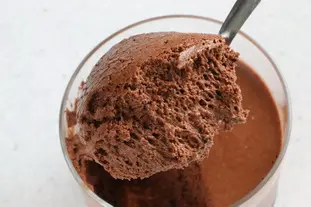
When you make a traditional mousse, that is to say without using a siphon, whatever the recipe, it's always the same principle: on one side you have a dense mixture, very tasty, and on the other side egg whites beaten until stiff.
All the difficulty of the success of a mousse, it will be to mix the two preparations which are of a very different density, without breaking everything, to obtain the famous mousse, subtle balance between lightness and taste.
All the difficulty of the success of a mousse, it will be to mix the two preparations which are of a very different density, without breaking everything, to obtain the famous mousse, subtle balance between lightness and taste.
5,573 18 4.6
Last modified on: April 3rd 2021
Keywords for this post:MousseChocolateFruitTrickMeringueThe 3 secrets of successful mousses
For a chocolate mousse for example, the classic of classics, on one side you have chocolate melted in cream and added yolks, and on the other the whites beaten to snow.
The whites are gently incorporated into the chocolate mixture, which is mainly air, no secret, this is THE most delicate part of the recipe, let's see some tips to get it right.
According to your recipe, you will put more or less things in it, and sugar or not, I remain a fan of simple things: dark chocolate melted in cream in a bain-marie, smoothed with a whisk, egg yolks are added, smoothed again with a whisk and that's it.
Associated tip: add the egg yolks only when the chocolate mixture is smooth with a whisk, and not too hot, just lukewarm, also with a whisk, then smooth carefully again.
Related tips: It's not about making meringue, but you'll get much nicer whites if you "tighten" them by adding 20g of caster sugar (for 3 whites) halfway through. Their texture will be smoother, more creamy, and they will be easier to fold into the chocolate.
Intuitively, you would perhaps pour the chocolate over the whites and mix? This would be a mistake, you would risk "breaking" the whites.
It's a bit long and tricky, but that's where all the work is done. Stop when all the whites are well incorporated, there are no more "bundles of whites" not incorporated, be patient, in the end it is long to finish this incorporation ...
Divide into individual moulds and put in the fridge for at least 3 hours.
The above example is based on a chocolate mousse, but you can make all kinds of mousse on the same principle (whites + mixture) with instead of chocolate a (custard) cream with the fruits of your choice, or even a fruit coulis, but in this case you have to put a little gelatine in it while it is hot otherwise your mousse will not take.
A mousse is always a light and pleasant dessert, which finishes a meal in beauty, especially if it was a little rich.
In summary: The 3 secrets of a successful mousse are :
1) Adding the yolks with a whisk in a not too hot preparation
2) Whip the whites until they are stiff with a little powdered sugar
3) Incorporation in 2 steps, first we relax the mixture with a little whites with a whisk, and only then we incorporate gently with a maryse.
The whites are gently incorporated into the chocolate mixture, which is mainly air, no secret, this is THE most delicate part of the recipe, let's see some tips to get it right.
The chocolate mixture
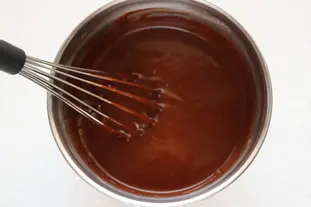
According to your recipe, you will put more or less things in it, and sugar or not, I remain a fan of simple things: dark chocolate melted in cream in a bain-marie, smoothed with a whisk, egg yolks are added, smoothed again with a whisk and that's it.
Associated tip: add the egg yolks only when the chocolate mixture is smooth with a whisk, and not too hot, just lukewarm, also with a whisk, then smooth carefully again.
Whipped egg whites
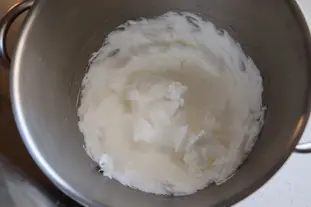
Related tips: It's not about making meringue, but you'll get much nicer whites if you "tighten" them by adding 20g of caster sugar (for 3 whites) halfway through. Their texture will be smoother, more creamy, and they will be easier to fold into the chocolate.
Mixing the 2As
I said, this is the difficulty, because you want to mix something very light, airy, with a very thick cream, and above all you want to keep the light side of the whites, to find it in the chocolate and form the mousse. So you can't go at it like a brute with a spoon, everything would fall back, it wouldn't be a mousse.Intuitively, you would perhaps pour the chocolate over the whites and mix? This would be a mistake, you would risk "breaking" the whites.
How do you do it?
You have to proceed in 2 steps: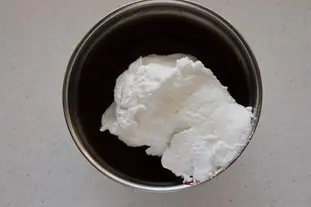
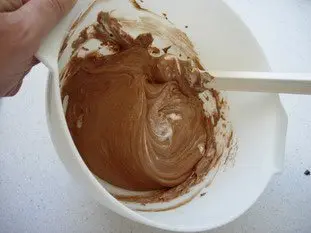
It's a bit long and tricky, but that's where all the work is done. Stop when all the whites are well incorporated, there are no more "bundles of whites" not incorporated, be patient, in the end it is long to finish this incorporation ...
Divide into individual moulds and put in the fridge for at least 3 hours.
The above example is based on a chocolate mousse, but you can make all kinds of mousse on the same principle (whites + mixture) with instead of chocolate a (custard) cream with the fruits of your choice, or even a fruit coulis, but in this case you have to put a little gelatine in it while it is hot otherwise your mousse will not take.
A mousse is always a light and pleasant dessert, which finishes a meal in beauty, especially if it was a little rich.
In summary: The 3 secrets of a successful mousse are :
1) Adding the yolks with a whisk in a not too hot preparation
2) Whip the whites until they are stiff with a little powdered sugar
3) Incorporation in 2 steps, first we relax the mixture with a little whites with a whisk, and only then we incorporate gently with a maryse.
Lasts posts
Wipe meats and fish before cooking
When you want to cook meat or fish, there's a very simple yet very important step to take before you even start: It's to dry, or wipe, each side of the meat or fish, sometimes called "dabbing" or "sponging". But why? And how? Let me explain.1,5115 April 14th 2024
Toss the salad
When you've finished preparing a salad, green or otherwise, it's usually time to add the dressing and toss. It's often said to "toss the salad", which means to season and mix. Is it easy? Not so easy...2,8505 March 8th 2024
Half milk, half cream
In a multitude of recipes, savoury or sweet, milk is used as the main ingredient, or at least as the main liquid ingredient. Milk is used instead of water, for example, because milk contains a proportion of fat, which adds roundness and softness to the recipe. This mellowness is very pleasant on...2,690 February 27th 2024
Cutting soft cheeses
As you may have already noticed, when you have to use a "soft" cheese in a recipe - their exact name is "soft cheese" - such as Camembert, Munster or Mont d'or, it's not easy to make anything other than thick slices.2,8095 February 20th 2024
It's spinning too fast!
When you need to grate or slice vegetables, you generally use an electric machine that does all the work: a food processor, a mixer with a "slicer" extension or similar. Are these machines really suitable? Generally speaking, yes of course, but there's one criterion that often poses a problem,...5,7755 November 12th 2023
Other pages you may also like
The 3 essential knives
You must have heard a chef or cook say: "There’s no good cooking without good ingredients". This is very true, of course, but for any amateur or beginner it is equipment that really counts to start with. What I mean is that you should not skimp on kitchen equipment, good utensils, a food...20K5 May 30th 2018
Raising (or leavening) agents
When we want to make a dough or batter rise when baking, either in patisserie or bread-making, we need to use a raising agent or leavening agent, one of which is called leaven. In the context of baking, a raising agent is simply what "makes something rise". It is a substance which, when added to...51K4.8 June 16th 2021
Perpetual stock
It's something you have probably have done yourself: cooked or pre-cooked vegetables before adding them to a recipe. This is almost always done the same way: peel the chosen vegetables (carrots, for example), cut them up, boil them in salted water (using a tablespoon or so of coarse salt per litre),...23K5 November 22th 2016
There is vanilla and vanilla
The vanilla is a delicious taste that can be found in many many dessert recipes, creams (the cream and the cream for example), ice creams, but also cakes and entremets. Whenever you need to add this vanilla note, you have several possible choices because vanilla is commercially available in...8,5485 December 14th 2017
Foie gras service
For the upcoming christmas meals you too may be sacrificing to the tradition of foie gras? If so, I suggest you take a look at everything that revolves around serving foie gras: how to serve it, and what to eat and drink with it.10K4.9 December 23th 2017
Follow this page
If you are interested in this page, you can "follow" it, by entering your email address here. You will then receive a notification immediately each time the page is modified or a new comment is added. Please note that you will need to confirm this following.
Note: We'll never share your e-mail address with anyone else.
Alternatively: you can subscribe to the mailing list of cooling-ez.com , you will receive a e-mail for each new recipe published on the site.









